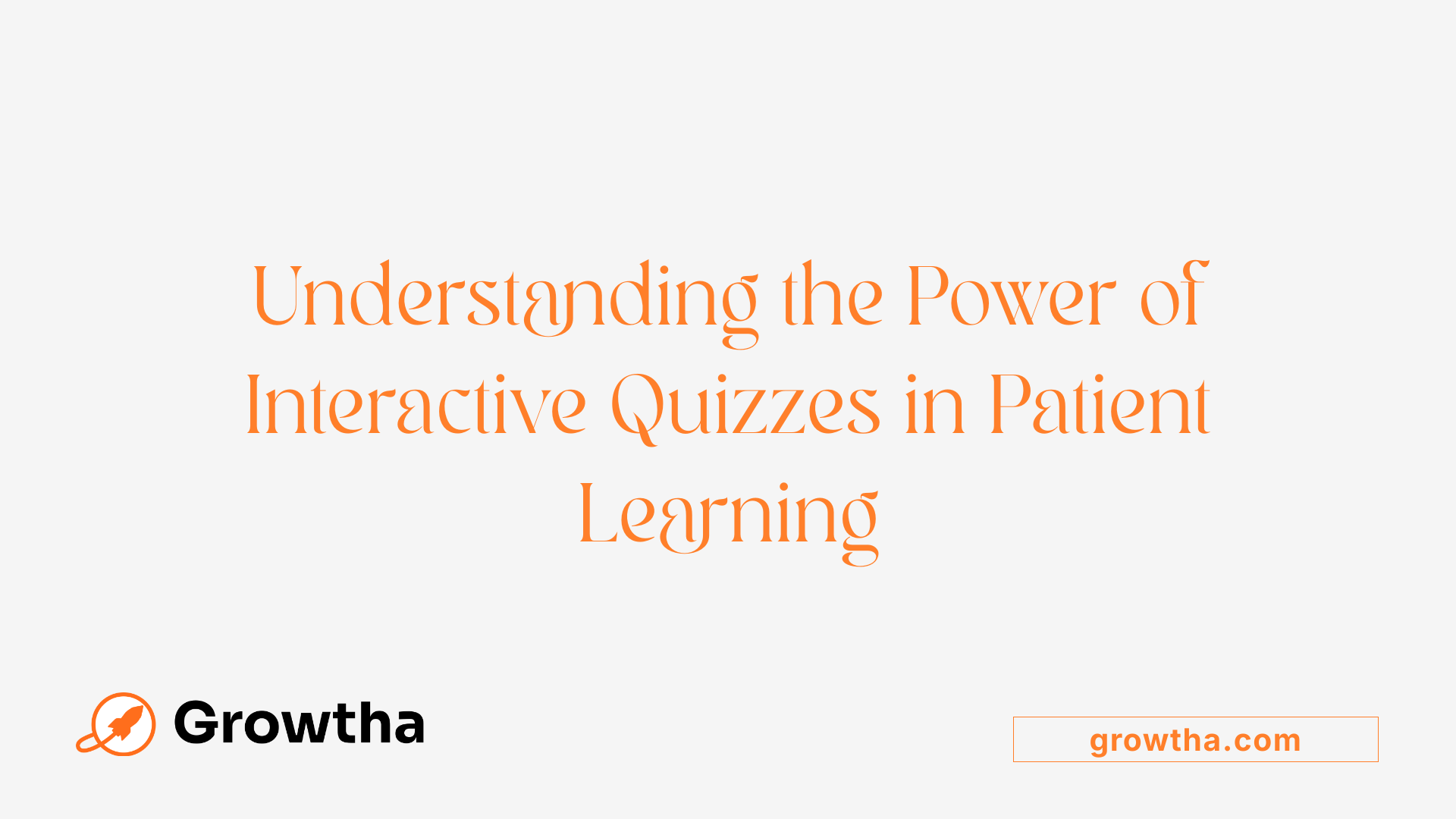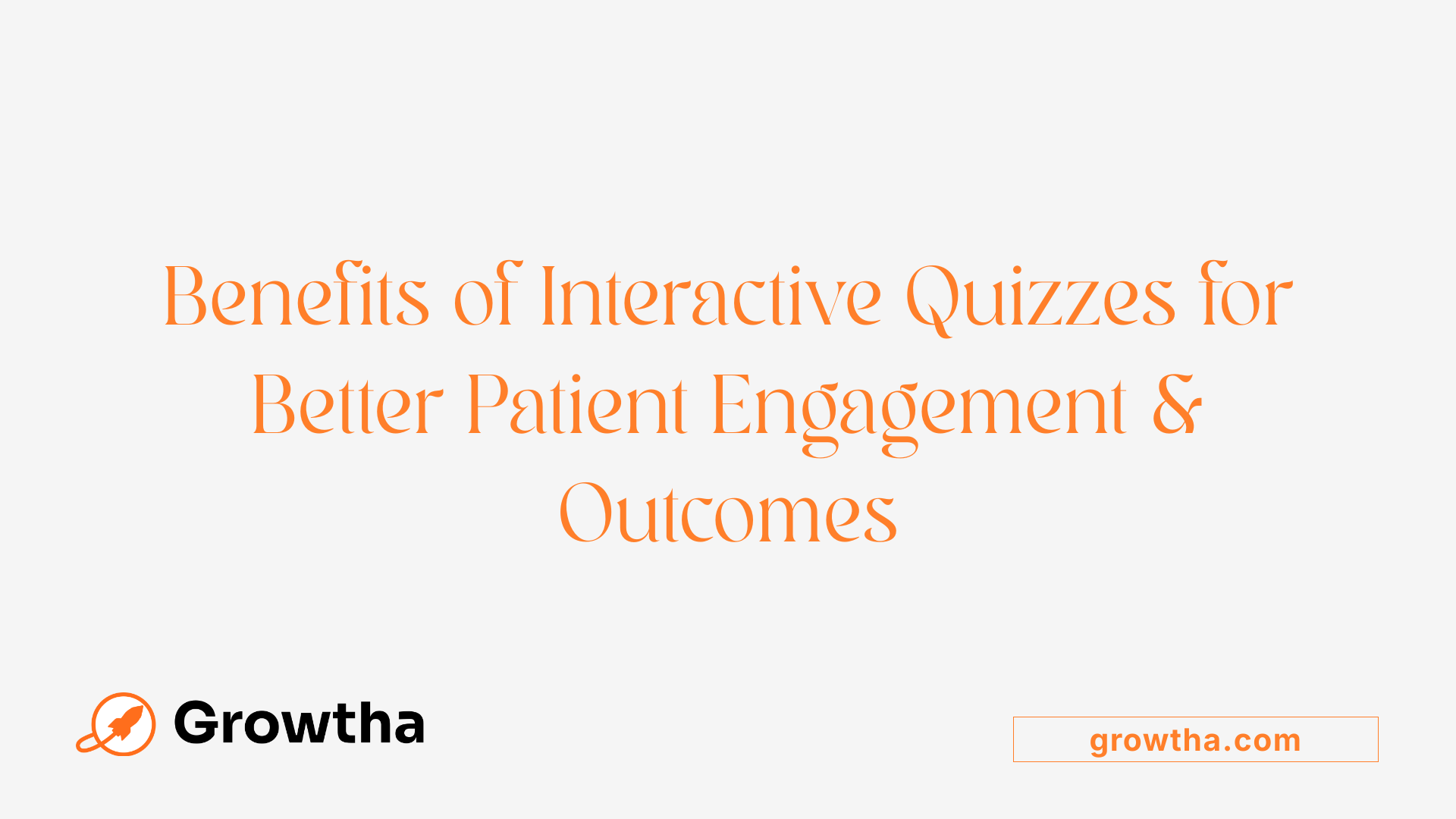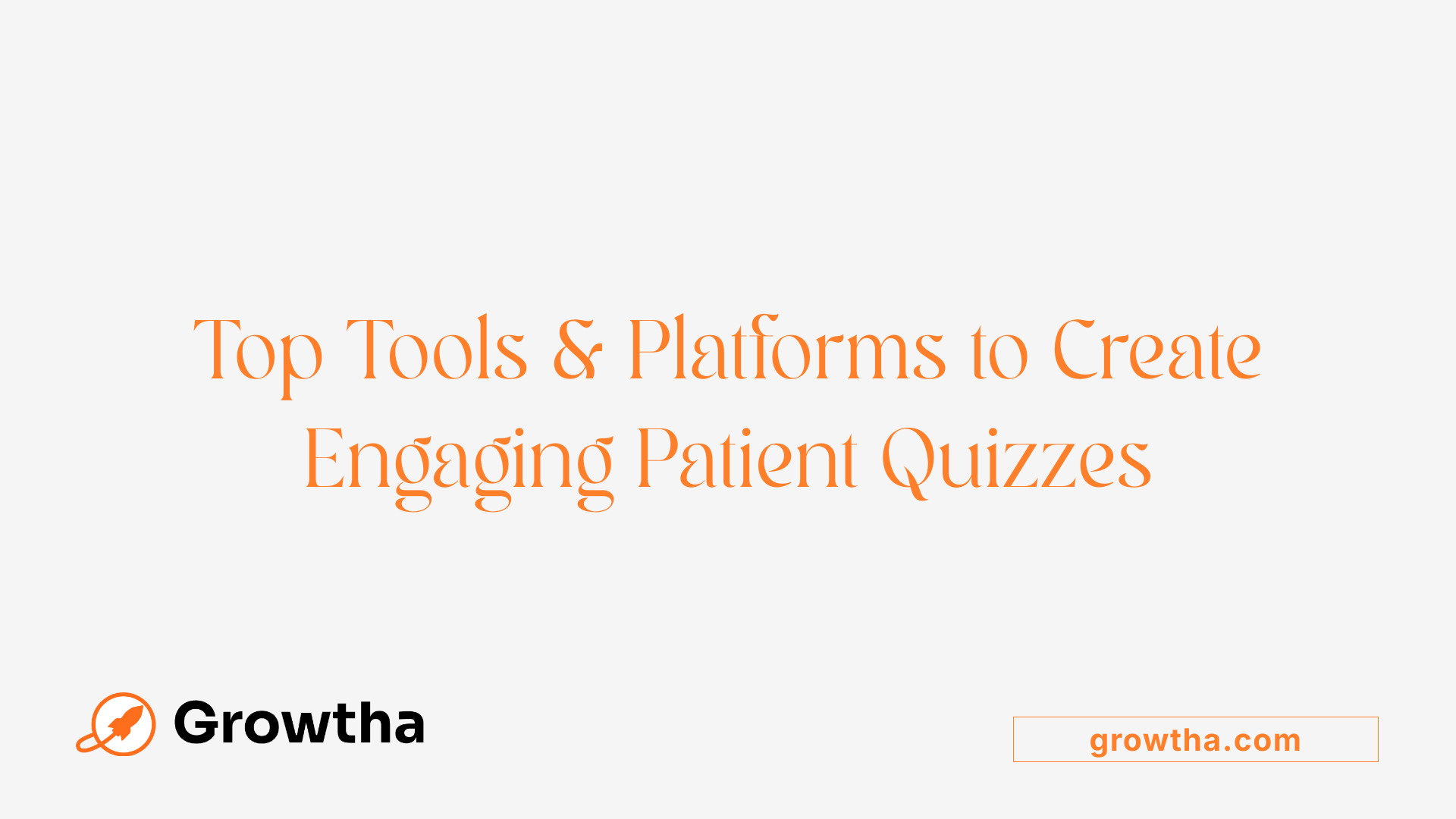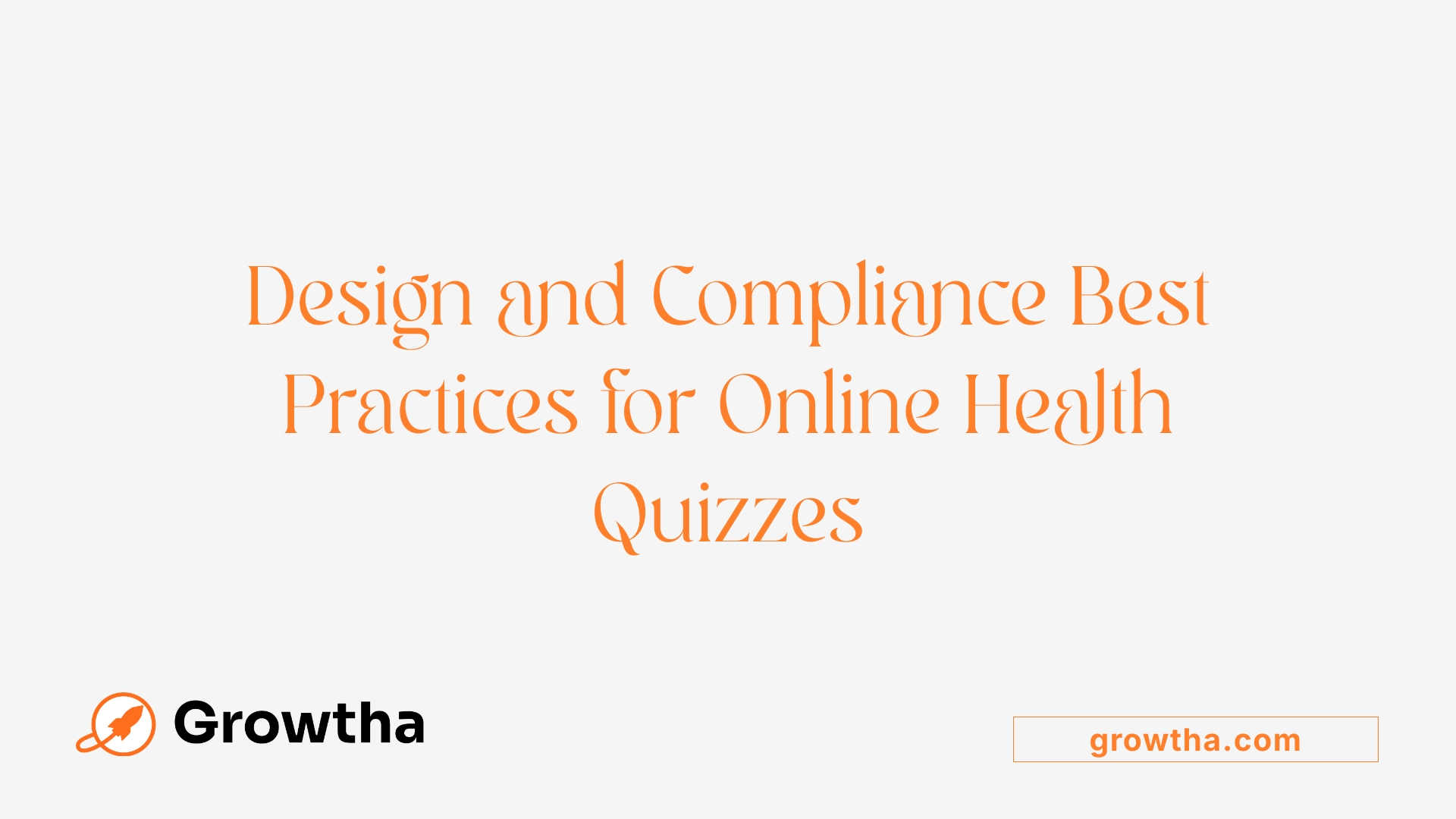How to Use Interactive Quizzes for Patient Education
Engaging Digital Strategies for Enhanced Patient Learning


How to Use Interactive Quizzes for Patient Education
Unlocking the Power of Interactive Quizzes in Healthcare
In an era where digital literacy is increasingly vital, interactive quizzes stand out as innovative tools to elevate patient education. They transform traditional health information delivery into engaging, personalized experiences that promote understanding, retention, and active participation. This article explores how healthcare providers can effectively utilize various interactive quiz formats and digital tools to improve patient outcomes, foster health literacy, and streamline communication with diverse patient populations.
Understanding Interactive Quizzes and Their Role in Patient Education

What are interactive quizzes and how are they used in patient education?
Interactive quizzes are digital tools designed to actively involve users through a series of questions, challenges, or assessments. These quizzes often include multiple-choice questions, true/false statements, matching exercises, or image-based prompts. They provide immediate feedback, making learning more engaging and personalized.
In healthcare, they serve multiple purposes. Patients can take quizzes to assess their understanding of medical conditions, treatment plans, or health behaviors. Healthcare providers incorporate quizzes into patient education programs to reinforce information, clarify misconceptions, and motivate active participation.
For example, a patient might complete a quiz about managing diabetes, which helps them better grasp dietary requirements or medication schedules. The interactive format not only increases retention—studies show knowledge improvements of up to 38%—but also makes the educational process more enjoyable and less intimidating.
Additionally, healthcare providers use these quizzes to collect valuable data. Responses reveal patient knowledge gaps, preferences, and behaviors, guiding personalized education strategies. This tailored approach enhances overall communication, encourages adherence to medical advice, and improves health outcomes.
Creating effective medical quizzes is accessible due to various online platforms. Many do not require coding skills, offering customizable templates suited for diverse educational needs. With options like gamified content, clickable images, and multimedia integration, healthcare professionals can craft engaging assessments that resonate with different patient groups.
Benefits of Using Interactive Quizzes for Patient Engagement and Health Outcomes

How do interactive quizzes affect patient engagement and health literacy?
Interactive quizzes play a vital role in enhancing patient engagement by transforming passive learning into active participation. These tools make health education more engaging, fun, and accessible, motivating patients to be involved in their care process. When patients answer questions related to their health conditions or treatment plans, they become more invested and attentive.
Further, quizzes improve understanding and retention of complex health information. Visual case scenarios, multimedia content, and scenario-based questions reinforce learning, making it easier for patients to grasp intricate topics like medication mechanisms or disease management.
Immediate feedback is another significant advantage. Patients instantly learn which concepts they understand well and where they need improvement. This timely information encourages patients to ask relevant questions and seek clarification, fostering better health decision-making.
In outpatient settings or waiting rooms, educational quizzes can raise awareness about preventive measures and screenings, prompting patients to adopt healthier behaviors. They also help reduce anxiety by demystifying medical procedures and conditions through engaging content.
Overall, integrating interactive quizzes into health communication strategies enhances patient satisfaction, supports adherence to treatment plans, and promotes better health outcomes by making learning personalized, approachable, and effective.
Strategies for Implementing Interactive Quizzes in Healthcare Settings

What are some best practices and strategies for implementing interactive quizzes in healthcare settings?
Effectively incorporating interactive quizzes into healthcare education and patient engagement programs involves a careful balance of design, technology, and ongoing assessment. First, creating content that is user-friendly and accessible ensures that diverse audiences, including patients with varying levels of health literacy, can engage comfortably. Simple language, clear instructions, and intuitive navigation are vital.
In healthcare environments, privacy and security cannot be overlooked. Ensuring compliance with regulations like HIPAA when collecting personal health information through quizzes is essential to maintain trust and legal standards.
Utilizing multimedia tools such as videos, animations, and gamification techniques can significantly boost engagement. These elements cater to diverse learning styles and make complex medical information easier to grasp. For example, animated videos can depict medication mechanisms, while gamified modules with points or badges motivate continued participation.
Incorporating various question formats such as case-based scenarios, image recognition, multiple-choice, and true/false questions promotes active learning and critical thinking. Immediate, personalized feedback helps patients and learners understand their progress and areas needing improvement, fostering confidence and self-efficacy.
Technology integration plays a crucial role. Using response systems, chatbots, and AI-driven personalization can adapt quizzes to individual needs, providing tailored educational experiences. Such tools also facilitate remote or online engagement, which is especially crucial in telehealth and during pandemics.
Embedding quizzes within broader educational frameworks—combining them with traditional counseling sessions or professional training—enhances reinforcing learning and ensures consistency. The teach-back method, where the patient explains concepts in their own words, can further confirm understanding.
For sustained effectiveness, continuous monitoring of engagement levels and learning outcomes is necessary. Regularly updating and refining quiz content based on user feedback, analytics, and emerging medical guidelines ensures relevance and maintains motivation.
In summary, a strategic approach blending thoughtful content design, technological innovation, and ongoing evaluation will maximize the impact of interactive quizzes in healthcare settings. These measures promote better understanding, adherence, and ultimately, improved health outcomes.
Tools and Platforms for Creating Effective Patient Education Quizzes
 Creating engaging and personalized patient education quizzes requires the use of advanced digital assessment tools and platforms. These tools enhance understanding by offering interactive, multimedia-rich content tailored to individual needs.
Creating engaging and personalized patient education quizzes requires the use of advanced digital assessment tools and platforms. These tools enhance understanding by offering interactive, multimedia-rich content tailored to individual needs.
Popular platforms like Google Forms and Kahoot! provide user-friendly interfaces to develop quizzes with various question types. These platforms support multiple-choice, true/false, and matching questions, enabling healthcare providers to assess patient knowledge effectively. Moreover, PrepAI stands out as an innovative platform that leverages artificial intelligence (AI) and natural language processing to automatically generate quiz questions from uploaded medical documents or key topics. This streamlines content creation, saving time while ensuring educational relevance.
Features of these platforms include customizable options for branding, question sequence, and scoring. Healthcare providers can tailor content to specific conditions or treatments, making the material more relatable and engaging for patients. Additionally, many platforms support multimedia integration, allowing inclusion of videos, images, and audio clips. This multimedia approach caters to different learning styles and enhances patient retention.
Incorporating multimedia elements is crucial for complex topics. For example, animated videos demonstrating medication mechanisms or virtual reality scenarios can reduce patient anxiety and improve comprehension. Platforms like PrepAI also allow embedding such materials directly within quizzes, creating comprehensive learning modules.
Automation features are increasingly important. Platforms such as Wooclap enable real-time analysis of quiz responses, helping clinicians identify knowledge gaps instantly. Automation also extends to scoring and providing immediate feedback, crucial for reinforcing learning during patient education.
In summary, the integration of digital assessment tools, multimedia content, and AI-driven features enables healthcare professionals to develop engaging, personalized patient quizzes. These interactive assessments not only boost understanding but also promote active participation, leading to better health outcomes.
| Tool/Platform | Key Features | Customization Options | Multimedia Support |
|---|---|---|---|
| Google Forms | Free, easy to use, collaborative | Branding, question order | Yes, images, videos |
| Kahoot! | Gamified quizzes, engaging | Themes, question types | Yes, images, videos |
| PrepAI | AI-generated questions, content upload | Content tailoring, question difficulty | Limited, mainly text-based but expandable |
| Wooclap | Interactive, real-time results | Question banks, multiple question types | Yes, images, audio, video |
Using these advanced platforms, healthcare providers can create effective assessments that foster continuous learning, tailored experiences, and higher engagement among patients.
Leveraging Digital and Multimedia Content to Boost Patient Education

How can digital tools and multimedia content be leveraged to enhance patient education through quizzes?
Digital and multimedia tools have revolutionized patient education by making learning more interactive, engaging, and personalized. Using videos, animations, and infographics allows healthcare providers to explain complex medical concepts in simplified and visually appealing ways. Incorporating these elements into quizzes not only captures patient attention but also reinforces key messages, leading to better understanding and retention.
Mobile apps tailored to individual health conditions serve as excellent platforms for delivering personalized quizzes. These apps can include multimedia content, quizzes, and interactive modules that patients can access anytime, anywhere. This flexibility supports continuous learning and helps patients stay informed about their treatment plans and health management.
Enhancing accessibility is another advantage of digital content. Content can be designed to accommodate various literacy levels, languages, and devices. Features like text-to-speech, adjustable fonts, and high-contrast visuals ensure that educational resources are usable by diverse patient populations.
Monitoring patient progress is made easier through digital platforms that track quiz attempts, scores, and time spent on content. Healthcare providers can analyze this data to identify areas where patients need additional support, tailoring subsequent educational interventions accordingly.
In summary, leveraging multimedia and digital tools in patient education transforms passive learning into active participation. Incorporating engaging videos, animations, and personalized quizzes fosters better understanding, adherence, and health outcomes, making healthcare information more accessible and effective.
Design and Compliance Guidelines for Online Health Quizzes

What are important design considerations and compliance aspects when creating online health quizzes?
Creating effective and trustworthy online health quizzes requires careful planning to meet legal, ethical, and usability standards. First and foremost, safeguarding patient privacy and data security is critical. Implementing compliance measures such as Health Insurance Portability and Accountability Act (HIPAA) standards, SSL encryption, and adhering to the General Data Protection Regulation (GDPR) ensures that personal health information remains secure and is handled appropriately.
Accessibility and usability are also vital aspects. Designing quizzes that follow the Web Content Accessibility Guidelines (WCAG) 2.0 AA ensures that users with disabilities or limited digital literacy can access and utilize the content effectively. This includes features like adequate visual contrast, alt text for images, keyboard navigation, and screen reader compatibility. The layout should be intuitive, with clear instructions and simple navigation, making it easy for all users to participate.
Content credibility and trustworthiness are fundamental in health-related assessments. Quizzes should be based on authoritative, up-to-date medical information. Incorporating multimedia elements such as images, videos, and patient testimonials not only enhances engagement but also reinforces trust. Including references or links to reputable sources can further improve the perceived reliability of the content.
Responsive design ensures that quizzes are accessible across a variety of devices, including smartphones, tablets, and desktops. This flexibility accommodates diverse patient preferences and enhances engagement. Clear, culturally sensitive language and visuals should be used to promote inclusivity, making content relatable and respectful of different backgrounds.
Finally, ongoing compliance with relevant legal and regulatory standards prevents legal risks and promotes health equity. Regular reviews and updates of the quiz content, along with adherence to privacy policies and accessibility laws, help sustain quality and ensure that every patient receives fair and secure educational experiences.
Summary Table:
| Aspect | What it Entails | Why it Matters |
|---|---|---|
| Legal and Regulatory Standards | HIPAA, GDPR compliance, data protection laws | Protects patient information, reduces legal risks |
| Accessibility and Usability | WCAG guidelines, mobile responsiveness, intuitive design | Ensures all users can access and benefit from the quiz |
| Content Credibility | Up-to-date info, authoritative sources, multimedia inclusion | Builds trust and promotes accurate learning |
| Data Privacy and Security | SSL encryption, secure servers, user authentication | Maintains confidentiality and trust |
| Cultural Competence | Culturally sensitive language, inclusive visuals | Promotes equity and respects diversity |
Following these guidelines helps create online health quizzes that are not only compliant but also engaging, trustworthy, and inclusive, ultimately supporting better health education and patient outcomes.
Harnessing Technology for Smarter Patient Education
Integrating interactive quizzes into healthcare education represents a powerful strategy to improve patient understanding, engagement, and health outcomes. Success hinges on selecting appropriate tools, designing user-centric content, ensuring compliance, and continuously monitoring educational effectiveness. As technology advances, innovations such as AI-enhanced personalization and immersive virtual environments promise to further transform patient education—from simple knowledge assessments to comprehensive health management platforms. By embracing these digital strategies, healthcare providers can create engaging, accessible, and effective educational experiences that empower patients and ultimately lead to better health for all.
References
- Interactive Patient Education: 5 Methods That Work - F.Learning Studio
- A Review of the Quiz, as a New Dimension in Medical Education
- Health Assessments & Social Media Quizzes | Practis
- Interactive Quizzes for Effective Learning & Assessment | Wooclap
- Interactive Quiz-Based Anatomy Teaching for Medical ...
- Interactive Quizzes: Index | WIC Works Resource System - USDA
- Pre-Course Online Quizzes: a Facile Way to Get Students up to ...
- Interactive Patient Education Content Creation | Infuse Media
- Quiz Strategies | Office of Digital Learning | University of Nevada ...
- Student engagement using multiple-attempt 'Weekly Participation ...







